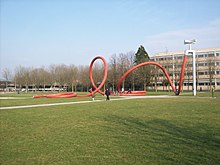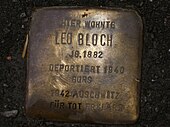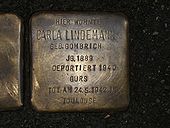Stühlinger
|
Stühlinger Freiburg im Breisgau |
|
|---|---|
| City district Freiburg (FR) Baden-Wuerttemberg , Germany |
|

|
|
| Basic data | |
| District of Freiburg | |
| District number: | 51 |
| Structure: | 2 districts: 512 Stühlinger-Eschholz 513 Alt-Stühlinger |
| Geographic location : | 48 ° 0 ′ 4 " N , 7 ° 50 ′ 17" E |
| Height : | 265 m above sea level NN |
| Area : | 1.74 km² |
| Residents : | 15,725 (December 31, 2017) |
| Population density : | 9037 inhabitants per km² |
| Proportion of foreigners : | 20% |
| Postal code : | 79106, 79115 |
| Area code : | 0761 |
| Internet presence: | www.freiburg.de |
The Stühlinger is a district of Freiburg im Breisgau west of the old town with around 15,700 residents (December 31, 2013). It is divided into the two districts of Stühlinger-Eschholz and Alt-Stühlinger. In the east it is bounded by the railway facilities of Deutsche Bahn AG with the main station , in the south by the Dreisam , in the west by the tracks of the freight railway and in the north it borders on the Brühl district . From 1967 to 2014, the district of Stühlinger-Beurendung, north of the Breisacher Bahn , was also administratively counted as part of the district, but since January 1, 2015, that district has been part of the Brühl-Beur specific district.
history
The area of today's Stühlinger used to be partly swampy fields and meadows. Farmers from Betzenhausen used the “Mittelheuweg” with their wagons on the way to the Münstermarkt, which roughly corresponded to today's tram route. The Lords of Stühlingen owned part of the agricultural land.
Two main factors led to the creation of the “Stühlinger”: on the one hand, the population growth in the second half of the 19th century, and on the other hand, the new railway line Offenburg - Basel that was built in 1845 . The freight transport was promoted with the new train station in Freiburg. The upswing after the Franco-Prussian War and the founding of the Empire in 1871 also brought further impetus.
The city therefore designated three streets parallel to the railway line with five cross streets as a new building area “Hinterm Bahnhof” like a drawing board. It was not until 1886 that people started talking about the “Stühlinger”. Field names of these areas were among others “Eschholz” and “Stühlinger” after the former owners, the lords of Stühlingen in Klettgau .
After 1875, the area beyond the train station was developed as planned. An underpass in the north of the station, which led to the road to Lehen, and the Stühlingerbrücke south of the station (today Wiwilíbrücke , also known as the “Blue Bridge” because of its paintwork), which opens onto the Stühlinger Kirchplatz, were the connections to the city. The Herz-Jesu-Kirche , based on the Limburg Cathedral, was built between 1893 and 1897 and soon became the visible center of the new district. Two school buildings were erected behind it, one each for girls and boys.
In addition to residential development, companies and public utilities also settled here. So the gas works , which up until then was located in the Wiehre (at today's location of the Johanneskirche ), was relocated to the south of the still young part of the city (today residential buildings on the two foundations called 2-cylinder ), right next to it the electricity works was built a little later . The Brenzinger & Cie. Company also settled nearby . , at that time a major construction company, the Lion Brewery was built by Louis Sinner in the immediate vicinity in 1888 . The Lederle pump factory (Lederleplatz) also found its place in the Stühlinger. The Theodor Kromer & Co. lock factory, the Klingele tinder factory, the M. Welte & Sons organ and orchestrion factory , the Gustav Bissier steam saw company, the Birmelin brothers' lifting tool factory, as well as smaller businesses such as a soap factory or the Ritzmann bone meal factory also moved into the area Stühlinger on.
From 1926 the new university clinics were built in the northern part . With the Luther Church, the Protestant Christians also received a new, striking house of worship (completed in 1916) on what was then Hohenzollernplatz (today Friedrich-Ebert-Platz ), which was completely destroyed in World War II and was then rebuilt in the simple style of the 1950s. It was de-dedicated in January 2016 and is to be converted into a lecture hall for the university clinic.
In 1877 the district care facility was opened on Eschholzstrasse.
After the bombing of November 27, 1944 , a rubble railway was operated from 1947 to 1949 to move the rubble from the destroyed buildings from the institute quarter to the former Flückiger gravel works. There is a presumption that the remains of the phosphorus bombs in the rubble were the cause of the high phosphorus content in the Flückigersee that was formed there.
After the Second World War, construction continued in the area west of Eschholzstrasse. Another Catholic church, St. Josef, and the Evangelical Kreuzkirche were built. A large vocational school center, today's town hall in Stühlinger , today's employment agency and a clinic for tumor biology as well as dormitories for students and nursing staff were added.
population
- Population density
The population density (inh / ha of populated area) in the districts of Stühlinger is above the average for Freiburg. In the district of Alt-Stühlinger it is more than twice as high as the average for the whole of Freiburg.
| Borough | Population density |
Residents |
|---|---|---|
| 512 Stühlinger Eschholz | 74.9 | 6,697 |
| 513 Alt-Stühlinger | 107.9 | 9,118 |
| Freiburg as a whole | 48.7 | 213,567 |
Buildings and facilities
- education
There are various day-care centers and kindergartens in Stühlinger. In the district there is the Hebelschule , a primary and secondary school and the Hansjakobschule secondary school , both of which are symmetrical on the west side of the Sacred Heart Church and were once built as a girls 'and boys' primary school . There are also secondary schools in the Stühlinger: In the west of the district is the large vocational school center , where various schools offer lessons for numerous professions. There is also the Max Weber School , which offers a wide range of school types in the field of business. While the nursing school of the university hospital has moved to the Brühl district , the physiotherapy school is still located on Fehrenbachallee.
- Business
Today you can find some cafés, pubs, restaurants, small alternative shops, as well as craft shops and retail shops in the Stühlinger.
- Other facilities
In addition to the university hospital already mentioned, the Federal Employment Agency and the town hall in the Stühlinger (formerly the Technical Town Hall) of the city are also housed in the Stühlinger. The district also houses several student residences , such as the Albertusburse , which is supported by a Catholic order, or the student residence hall of the Freiburg Student Union on Engelbergerstrasse. The former power station E-Werk is to be mentioned as a cultural institution , which contains artist studios, various venues for theater groups and exhibition options.
- Green spaces
In front of the Herz-Jesu-Kirche is the Stühlinger Kirchplatz , which is particularly busy in summer. Between the Max Weber School and the vocational school center lies the spacious Eschholzpark , the landmark of which is an oversized garden hose with a tap by the artist couple Coosje van Bruggen / Claes Oldenburg ; this should remind of the earlier horticultural use of the site. There are also numerous children's playgrounds in the district, including the Rumpelhausen eV adventure playground on Ferdinand-Weiß-Straße, a playground on urban premises operated by families living in Stühlinger.
Memorials
In the Stühlinger there are various memorials to the history of the district as well as those related to the history of Freiburg in general. These include:
- The five-wound cross commemorates soldiers who fell ill and died in 1813/14 and were buried here in a mass grave.
- The memorial stone on Hildaspielplatz (Kreuzstrasse) for the victims of the mistaken bombing of Freiburg by the German Air Force on May 10, 1940
- At the main entrance to the Hebelschule, a plaque commemorates the deportation of the Jews from Baden to the Gurs camp on the night of October 21 to 22, 1940 by the Nazis as part of the Wagner-Bürckel campaign . The schoolyard between the Hebel school and the neighboring Hansjakob school was the central meeting point in Freiburg. A memorial on the Wiwilí Bridge also reminds of this process - a coat with a bronze Jewish star that was forgotten in a hurry .
- Since 2006 another Gurs memorial, memorial project Neckarzimmern , consisting of a stone sculpture and a text board , on the Stühlinger church square.
- A memorial stone in front of the site of the former district nursing home for the mentally and physically handicapped commemorates its dissolution by the National Socialists in 1940 and the subsequent murder of many of the almost 600 nurses as part of the National Socialist murders who were victims of National Socialist racial madness.
- The memorial plaques for Berndt Koberstein and Albrecht ("Tonio") Pflaum on the Wiwilí Bridge commemorates two citizens of Freiburg who were murdered by the Nicaraguan Contras in Wiwilí .
- In the Stühlinger there are several stumbling blocks intended to remind of the fate of the people who were murdered, deported, expelled or driven to suicide by the National Socialists. There were:
Surname Year of birth Residence Stühlinger Year and place of deportation Another fate Karl Balzer 1885 Lehener Strasse 14 Arrested in 1943 Death December 18, 1943, Bruchsal prison Leo Bloch 1882 Engelbergerstrasse 39 1940 Gurs 1942 Auschwitz ; pronounced dead Nathan Bloch 1878 Engelbergerstrasse 39 1940 Gurs 1942 Auschwitz; pronounced dead Robert Burgheimer 1882 Klarastrasse 29 1940 Gurs Death in Auschwitz Ida Heilbrunner 1890 Egonstrasse 48 1940 Gurs Murdered in Auschwitz Carla Lindemann, b. Gombrich 1889 Engelbergerstrasse 39 1940 Gurs Death on May 24, 1942 in Toulouse Kurt Lindemann 1876 Engelbergerstrasse 39 1940 Gurs Survived Max Maier 1880 Fedderstrasse 6 1943 Murdered in Majdanek Christian Nussbaum 1888 Barbarastr. 1 Arrested in 1933 Death in Wiesloch in 1939 Gustav Adolf Weber 1904 Lehener Strasse 14 deserted in 1943 shot dead June 29, 1943, on the run in the Rhine near Maxau
traffic
Four of the five Freiburg tram lines (1, 2, 3, 4) run through the Stühlinger - from the city center over the Stühlinger Bridge , crossing the tracks of the Freiburg Central Station . The bus line 14 of the Freiburger Verkehrs AG connects the Eschholzstraße with Haslach and the industrial area Haid. In the north of the Stühlinger is the S-Bahn station Klinikum of the Breisacher Bahn .
The city center can be reached on foot or by bike via the Stühlinger Bridge or the Wiwilí Bridge next to it. Further connections to the city center exist through the underpass north of the main station to Lehener Straße for pedestrians and cyclists as well as at the feeder Mitte and the Dreisam and - only for pedestrians - the underpass under the platforms of the main station.
There is a DB car sharing station as well as parking spaces for the first Freiburg car sharing provider, Stadtmobil Südbaden AG , at the bike station and at other locations.
Eschholzstrasse was designated in the 2002 traffic development plan as a “road section with unbearable traffic load”. A “significant excess of the tolerable load” is determined. The redesign of Eschholzstrasse with improved cycle paths and a reduction in the maximum speed limit to 30 km / h in the evening and at night has reduced the burden of motor vehicle traffic.
Individual evidence
- ↑ http://www.badische-zeitung.de/freiburg-nord/zwei-quartiere-sind-nun-offiziell-eins--88517892.html
- ↑ Hans Schadek: Freiburg then-yesterday-today . Steinkopf Verlag , Stuttgart 2004, ISBN 3-7984-0771-1 , p. 121 ff.
- ↑ Carola Schark: The Luther Church shaped the Stühlinger district until it was destroyed. Badische Zeitung, March 24, 2019, accessed on March 30, 2019 .
- ↑ stuehlinger-online.de: News (period: May 1st , 2004 - May 15th, 2004) ( Memento of July 8th, 2004 in the Internet Archive ).
- ↑ Lars Bargmann: Phosphorus bombs in the rubble , Badische Zeitung of November 24, 2003, accessed on February 26, 2011.
- ^ Evaluation of the population register, Office for Citizen Service and Information Processing, Freiburg, population density. ( Page no longer available , search in web archives ) Info: The link was automatically marked as defective. Please check the link according to the instructions and then remove this notice. As of January 1, 2012.
- ↑ Number of people according to small-scale breakdown. ( Page no longer available , search in web archives ) Info: The link was automatically marked as defective. Please check the link according to the instructions and then remove this notice. As of December 31, 2011
- ^ Education at the University Medical Center Freiburg. Retrieved March 30, 2019 .
- ^ Physiotherapy University Hospital Freiburg. Retrieved March 30, 2019 .
- ↑ freiburg-im-netz stumbling blocks - documentation. Accessed October 20, 2009.
- ^ Photo at Wikimedia Commons: Stolperstein
- ↑ Locations Stadtmobil CarSharing Südbaden. Retrieved August 29, 2017 .
- ↑ Transport Development Plan VEP 2020 ( Memento from August 31, 2009 in the Internet Archive )
- ↑ Sections of road with incompatible vehicle loads.
literature
- Heiko Haumann , Hans Schadek (Hrsg.): History of the city of Freiburg im Breisgau . Vol. 3, Stuttgart 1992, ISBN 3-8062-0857-3 , p. 359 ff.
- Local association Freiburg-Stühlinger (ed.): Der Stühlinger: Festschrift for the 850th anniversary of the city of Freiburg im Breisgau. Freiburg 1970.
- Local association Freiburg-Stühlinger (publisher): 100 years of Stühlinger: 1885–1985. Freiburg 1985, DNB 891664831 .









